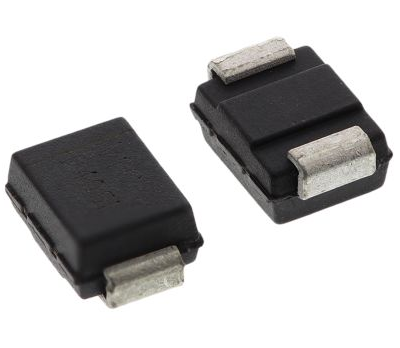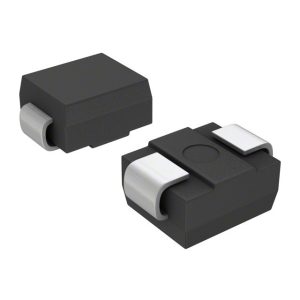10BQ015
Part Number: 10BQ015
Manufacturer: Vishay Semiconductors
Description: Schottky Diodes & Rectifiers
Shipped from: Shenzhen/HK Warehouse
Stock Available: Check with us
ICRFQ.com - Electronic Components Distributor in China Since 2003

Part Number: 10BQ015
Manufacturer: Vishay Semiconductors
Description: Schottky Diodes & Rectifiers
Shipped from: Shenzhen/HK Warehouse
Stock Available: Check with us
| Category | Discrete Semiconductor Products |
|---|---|
| Family | Diodes – Rectifiers – Single |
| Manufacturer | Vishay Semiconductor Diodes Division |
| Series | – |
| Packaging | Bulk |
| Diode Type | Schottky |
| Voltage – DC Reverse (Vr) (Max) | 15V |
| Current – Average Rectified (Io) | 1A |
| Voltage – Forward (Vf) (Max) @ If | 350mV @ 1A |
| Speed | Fast Recovery =< 500ns, > 200mA (Io) |
| Reverse Recovery Time (trr) | – |
| Current – Reverse Leakage @ Vr | 500μA @ 15V |
| Capacitance @ Vr, F | – |
| Mounting Type | Surface Mount |
| Package / Case | DO-214AA, SMB |
| Supplier Device Package | SMB |
| Operating Temperature – Junction | -55°C ~ 125°C |
The VS-10BQ015-M3 surface mounts Schottky rectifier is a good choice for use in devices with limited board real estate as a result of its diminutive size as well as its low forward drop. When utilizing the barrier technology protected by a patent, the maximum junction temperature that may be safely operated is 125 degrees Celsius. The most common areas to find them in operation are disc drives, freewheeling diodes, converters, reverse battery protection switching power supplies, and battery charging.

A metal-semiconductor junction diode is referred to as a Schottky diode. This type of diode is known as a hot-carrier diode, a low-voltage diode, and a Schottky barrier diode. A Schottky diode is produced at the junction where metal and semiconductors come together.
Low forward voltage drop and rapid switching action are the two characteristics that set Schottky diodes apart. A PN junction diode is well known to consist of a junction between p-type materials and n-type materials.
On the other hand, a Schottky diode substitutes metals like platinum or aluminum for P-type semiconductors.
A metal-semiconductor junction is created between a metal and a semiconductor, forming a Schottky barrier (instead of a semiconductor–semiconductor junction as in conventional diodes). N-type silicon is often used as a semiconductor, and platinum, molybdenum, chromium, or tungsten are frequently used as metals.
Some silicides, such as palladium silicide and platinum silicide, may also be utilized. Because the metal side of the diode serves as the device’s anode and the n-type semiconductor side serves as the device’s cathode, this indicates that conventional current can flow from the metal side to the semiconductor side of the diode but not the other way around. This Schottky barrier enables highly rapid switching while reducing the amount of forwarding voltage drop.
The diode’s forward voltage is determined by the particular combination of the metal and the used semiconductor. Schottky barriers can form in semiconductors of both the n-type and the p-type. On the other hand, p-type semiconductors often have a very significantly lower forward voltage. Because the reverse leakage current increases rapidly with a decrease in the forward voltage, the forward voltage cannot be too low.
As a result, the range typically used is between 0.5 and 0.7 V, and p-type semiconductors are used only in extremely uncommon circumstances. The temperatures required for source/drain annealing in CMOS processes can be withstood by titanium silicide and other refractory silicides. But because the forward voltage of these silicides is frequently too low to be effective, procedures that employ them often do not provide Schottky diodes.
A Schottky barrier, a depletion layer, can be created at the junction of an n-type semiconductor and a metal. The potential energy barrier that is produced at the metal-semiconductor junction is referred to as the Schottky barrier. For the electrons to travel through the diode, they must first overcome this potential energy barrier.
A rectifying Schottky barrier is created by the junction of a rectifying metal and a semiconductor. This rectifying Schottky barrier is essential in producing a device known as a Schottky diode. A metal and a semiconductor that does not conduct electricity in the opposite direction come together to produce a non-rectifying Schottky barrier.
Because of their rapid switching rates and ability to operate at high frequencies, Schottky diodes are ideally suited for radio frequency applications. Additionally, because Schottky diodes have several different configurations for the metal-semiconductor junction, these semiconducting devices might be used in power detectors or mixer circuits.
Because they differ from standard PN junction devices in that they have both a high current density and a low forward voltage drop, Schottky diodes are the best semiconductor devices to use in power rectifier applications. Due to this, Schottky diodes are the ideal semiconductor components for power rectifiers. These benefits lead to smaller heat sinks being incorporated into the design, decreased heat levels, and increased overall electrical system efficiency.
Applications that require current to be generated by two power supplies in parallel may benefit from the usage of Schottky diodes. Due to the fact that Schottky diodes have a low forward voltage drop, they are ideally suited for use in applications that involve electricity or circuitry. Additionally, the presence of these diodes prevents current from flowing from one source into another in the opposite direction.
Because the sun cannot be used as a source of energy at all times of the day, solar cells are frequently combined with rechargeable batteries in order to store energy for later use. SiC Schottky diodes stop both high-performance solar cells from releasing through lower-performance solar cells and the batteries from discharging through the solar cells at night.
Schottky diodes are utilized as switches in applications involving fast-clamp diodes. In this instance, the base junction is skewed forward. Schottky diodes dramatically shorten the turn-off time while accelerating the circuit speed. Schottky diodes significantly reduce the turn-off time while also speeding up the circuit.
Gratitude for reading. Use the comment area below to let us know if there is anything we should have covered or if you have any questions about this or any other article on our website. Browse our website at your leisure to find even more exciting content.
If you have any inquiries or need to place an order for 10BQ015, then ICRFQ is your best choice. When you get in touch with us, we will ensure that you get the best product at the very best price possible because we are the most reputable electronic distributor in China.
WhatsApp us